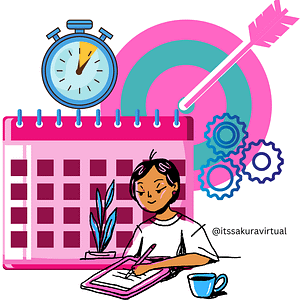Clockwise: How Successful Entrepreneurs Manage Their Time
There are 24 hours, which is 1,440 minutes, or 86,400 seconds in a day. No matter what we do, the amount of time in a day does not change. What we do with this time is what makes us successful.
I can’t tell you how many times I have thought where did the day go? I can’t believe it’s 5pm already!
I feel like the older I get the faster the day, months and years fly by.
Time Management Definition
Time management means deciding on the best way to use your time so you can get things done efficiently. It involves planning, prioritizing tasks, and staying focused to achieve your goals without feeling overwhelmed.
It means working smarter rather than harder and achieving a better work life balance.
Key aspects of time management include:
- Setting Goals: Know what you want to accomplish in the short term and the long term.
- Prioritizing Tasks: Decide which tasks are most important.
- Planning: Figure out how to use your time to finish tasks on time. Create a schedule or a to do list.
- Organizing: Keep track of what needs to be done and when.
- Delegating: Outsource work so it frees up some of your time and you don’t get overwhelmed.
- Eliminating or Minimizing Time Wasters: Reduce distractions so you can focus.
- Using Tools and Techniques: There are many tools that are available. Use productivity tools, such as calendars, task lists, planners and time-tracking apps, to enhance efficiency.
- Reviewing and Adjusting: See what works and adjust your approach accordingly.
5 Ps of Time Management
The “5 Ps of Time Management” is an organized approach to help you use your time well. Each “P” stands for an important principle that, when used together, can boost your productivity.
Prioritize: This means deciding which tasks are most important and urgent. By tackling the most crucial tasks first, you ensure that your time is spent on things that really matter for your goals or duties.
Plan: Planning means making a schedule for how you’ll use your time. It’s about setting goals, breaking them into smaller tasks, and deciding how much time to spend on each task. A good plan keeps you organized and helps you avoid putting things off or wasting time.
Prepare: Preparation means getting ready to do your tasks well. This includes gathering what you need, setting up your space, and making sure everything is ready for you to work efficiently. Being prepared helps you start working smoothly and without interruptions.
Proceed: After you’ve figured out what’s most important, made a plan, and got everything ready, it’s time to get moving. Proceeding means sticking to your plan and actually doing the tasks you’ve set out to do. It takes discipline to stay focused and avoid getting sidetracked.
Persist: Persistence means keeping at it with steady effort and staying committed to your schedule and goals. It’s about staying motivated and not giving up, even when things get tough or don’t go as planned.
My favorite out of the 5 p’s is planning. I love lists, planners, crossing things off my list. I am not even going to tell you how many journals I own!
What is the “1 Yes, 3 Less Rule?”
What does 1 yes, 3 less rule mean? The idea behind the “1 Yes, 3 Less” rule is to enhance productivity by channeling your energy and efforts into a manageable number of important tasks, rather than trying to juggle many tasks at the same time.
1 Yes: Identify and commit to one main priority or goal that you want to achieve.
3 Less: Limit yourself to no more than three main tasks or goals at any given time. By keeping your focus on a few key priorities, you avoid spreading yourself too thin.

Time Management Techniques
What are some techniques other than the time blocking method?
Pomodoro Technique
The Pomodoro Technique is a time management method developed by Francesco Cirillo in the late 1980s. It’s designed to improve focus and productivity by breaking work into intervals, traditionally 25 minutes in length, separated by short breaks.
How does it work?
- Task: Select a task that you want to work on. These could be business activities, client meetings, etc.
- Set a Timer: Set a timer for 25 minutes. This period is called a “Pomodoro,” named after the tomato-shaped kitchen timer that Francesco Cirillo used. Do you remember those tomato looking timers?
- Work on the Task: Focus solely on the chosen task until the timer rings. Avoid distractions and interruptions. If you think of something unrelated that you need to take care of, write it down and get back to the task you are working on.
- Take a Short Break: When the timer goes off after 25 minutes, take a break for 5 minutes. Use this time to relax, grab a drink, or do something unrelated to work.
- Repeat: After the short break, start another Pomodoro (25 minutes of work) on the same task. Repeat this cycle—25 minutes of focused work followed by a 5-minute break.
- Longer Breaks: After completing four Pomodoros (a total of about 2 hours of focused work), take a longer break of 15-30 minutes. Use this time to recharge before starting the next set of Pomodoros.
The technique can be adjusted to suit individual preferences and tasks. Some people find shorter or longer Pomodoro intervals work better for them.
Eisenhower Matrix
The Eisenhower Matrix, also called the Urgent-Important Matrix, is a powerful tool for sorting tasks based on their urgency and importance, helping users prioritize effectively. It was popularized by Dwight D. Eisenhower, the 34th President of the United States, who was known for his productivity and time management skills.
How does it work?
Urgent vs. Important:
- Urgent tasks – Needs immediate attention and usually carries deadlines or consequences if it’s not dealt with right away.
- Important tasks – Play an important role in achieving long-term goals, regardless of how urgent it is.
Four Quadrants:
- Quadrant 1 (Urgent and Important): These tasks need to be done right away and are critical for reaching your goals or avoiding problems. Examples include deadlines, emergencies, and urgent issues.
- Quadrant 2 (Important but Not Urgent): Tasks in this quadrant are important for your future success but don’t need to be done right away. It’s important to plan and schedule them so they don’t become urgent later on. Examples include making long-term plans, building relationships, and personal growth activities.
- Quadrant 3 (Urgent but Not Important): Tasks in this quadrant are urgent but not very important for your overall goals or long-term success. They’re often distractions that can be given to someone else or made less important. Examples are emails that aren’t important, interruptions, and small problems.
- Quadrant 4 (Not Urgent and Not Important): These tasks aren’t urgent or important and usually waste time. It’s best to get rid of them or reduce how much time you spend on them to have more time for important things. Examples are spending too much time on social media, having meetings that aren’t necessary, and doing small, unimportant tasks.
Application:
- Prioritization: Place each task into one of the quadrants based on its importance.
- Action Planning: Focus on tasks in Quadrants 1 and 2 to make sure you’re addressing critical and impactful activities. Delegate tasks in Quadrant 3 if possible and eliminate or minimize tasks in Quadrant 4.
- Time Management: The matrix helps you manage your time more effectively by guiding them to allocate resources to tasks that align with their goals and values.
- Decision-Making: It facilitates informed decision-making by providing a clear framework for evaluating tasks and their implications.
Eat That Frog
“Eat That Frog” is a metaphor popularized by Brian Tracy in his book titled “Eat That Frog!: 21 Great Ways to Stop Procrastinating and Get More Done in Less Time.”
The phrase comes from the idea that tackling your most challenging or important task first thing in the morning. By doing so, you’re metaphorically “eating the frog” early in the day, which means handling the most difficult task before moving on to other, less challenging activities.
The idea is to prioritize and accomplish the task that will have the biggest impact on your goals, productivity, and overall success, thus setting a productive tone for the rest of the day.
How does it work?
Identify Your Frog: Determine the task that is the most critical, impactful, or challenging—the one you’re most likely to procrastinate on.
Start Early: Begin working on this task as soon as you start your workday, ideally in the morning when your energy and focus are highest.
Focus and Commit: Set aside dedicated time and attention to this task without distractions. Use techniques like time blocking or the Pomodoro Technique to maintain focus.
Achieve Completion: Aim to complete the task or make significant progress on it before moving on to less critical tasks.
Benefits of the “Eat That Frog” Approach:
- Productivity Boost: By tackling your most challenging task first, you set a productive tone for the rest of the day.
- Mental Clarity: Completing a difficult task early can alleviate stress and free up mental energy for other tasks.
- Priority Management: Ensures that important tasks don’t get sidelined by less critical activities.
- Motivation: Starting with a significant accomplishment early in the day can motivate you to tackle other tasks with confidence.
Tips for Effective Implementation:
- Plan Ahead: Identify your frog the day before or first thing in the morning.
- Break it Down: If the task is large, break it into smaller, manageable steps to make it less intimidating.
- Stay Disciplined: Resist the temptation to procrastinate or delay starting the task.
Related Content: Mompreneurs – Leading the Way in Business and Parenting
Benefits of Time Management for Entrepreneurs
Increased Productivity: By focusing on one task at a time, entrepreneurs can accomplish important tasks efficiently without feeling overwhelmed. You are able to meet deadlines and make better decisions.
Improved Focus: The Pomodoro Technique encourages deep work and minimizes distractions, allowing entrepreneurs to concentrate fully on critical business activities.
Better Work-Life Balance: Finding a good balance between work and personal life is really important for entrepreneurs. When you can balance the needs of your business with taking care of yourself, it helps you work better, feel happier, and succeed in the long run.
Reduced Stress: Regular breaks help maintain mental freshness and prevent burnout, crucial for sustaining long-term productivity and creativity.
More Free Time: Time for personal activities, hobbies, exercise, and family time.
What are Some Time Management Tools/Apps?
Nowadays there is an app for everything! Following are some tools that you might like to use.
- Todoist
- Asana
- Trello
- ClickUp
- Monday.com
- Google Calendar
- Slack
- Evernote
- Calendly
- Time Doctor
- Toggl
- Airtable
- Forest
- Cold Turkey
- 1Password
I have used most of the tools above and they are all great. Out of Asana, Trello and ClickUp, my favorite is Asana.
In Conclusion
In summary, mastering time management is important for entrepreneurs balancing business challenges and personal life. Prioritizing tasks, setting clear goals, and using the right tools streamline workflows and boost productivity. Effective time management enables entrepreneurs to seize opportunities, innovate, and succeed in the fast-paced world of business.


